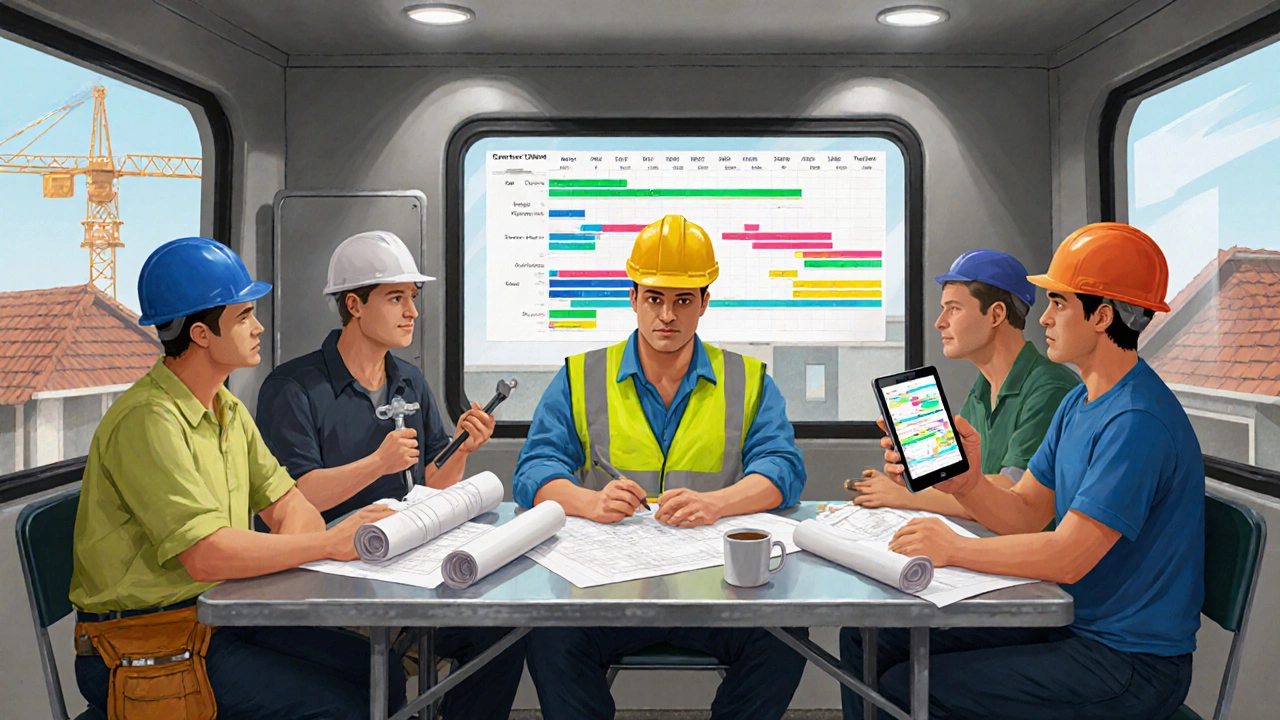Construction Budget Estimator
Project Budget Calculator
Estimate your construction project costs based on size, complexity, and location
Estimated Budget
| Base Construction | £0 |
| Permits & Inspections | £0 |
| Materials | £0 |
| Contingency | £0 |
| Total | £0 |
Key Insight from General Contractors
As mentioned in the article, experienced contractors build in 10-15% contingency for unexpected issues. This tool shows why budget flexibility is crucial - never underestimate permit timelines or material price fluctuations.
Contractor Tip
The article highlights that lowball bids often hide hidden costs. Always request detailed line-item estimates from your contractor, especially for materials and labor. This prevents costly change orders later.
Key Takeaways
- A general contractor oversees the entire construction process from start to finish.
- They coordinate subcontractors, manage budgets, schedules, permits, and quality.
- They act as the main point of contact between the owner, architect, and suppliers.
- Hiring the right contractor involves checking licenses, insurance, past projects, and communication style.
- Understanding their duties helps avoid delays, cost overruns, and legal issues.
When you hear the term General Contractor is the professional who assumes overall responsibility for planning, coordinating, and supervising a construction project, you might wonder what that actually looks like on a building site. In simple terms, a general contractor is the on‑site manager who makes sure everything runs smoothly.
Core Role of a General Contractor
The central purpose of a general contractor is to turn architectural plans into a finished building while keeping the owner’s goals in mind. This means they handle the Construction Project as a single, cohesive effort, aligning the work of many trades, material suppliers, and regulators.
Key Responsibilities
Below are the headline duties you can expect:
- Project Planning: Develop a detailed execution plan that outlines phases, milestones, and required resources.
- Permits & Inspections: Secure the necessary Building Permit and schedule inspections at critical points.
- Hiring Sub‑trades: Identify, vet, and contract qualified Subcontractors for electrical, plumbing, framing, and more.
- Materials Procurement: Order and deliver materials on time, avoiding storage issues and price spikes.
- Budget Management: Track expenses against the agreed Budget, flagging overruns early.
- Schedule Control: Keep the work on the agreed Schedule, adjusting for weather or supply delays.
- Quality Assurance: Conduct daily site inspections to ensure work meets specifications and codes.
- Safety Oversight: Enforce health‑and‑safety standards, provide PPE, and hold toolbox talks.
- Communication: Serve as the single point of contact for the Owner, the Architect, engineers, and suppliers.

Managing Subcontractors and Suppliers
Subcontractors are the specialists who actually perform the trades. A general contractor’s job is to sequence their work, monitor performance, and resolve conflicts. For example, the plumber can’t start until the framing is dry‑in; the roofer can’t work until the windows are installed. The contractor’s schedule must respect these dependencies.
Good subcontractor management also means protecting the owner from liability. The contractor typically carries the required insurance and bonds, so if a trade goes bust, the project can continue without the owner having to chase down a new vendor.
Budget and Schedule Control
Cost overruns are the number‑one complaint from owners. A skilled general contractor uses a combination of detailed cost estimating software and regular field updates to keep the Budget in check. They compare actual spend to the forecast each week, and if a line item exceeds a predefined variance (often 5‑10%), they propose corrective actions such as value‑engineering or scope adjustments.
The Schedule is visualised with tools like Gantt charts or construction‑specific software (e.g., Procore, Buildertrend). Critical path analysis highlights tasks that cannot slip without delaying the whole project. The contractor constantly monitors weather reports, delivery dates, and labor availability to keep those critical tasks moving.
Permits, Inspections, and Compliance
Every construction site must comply with local building codes, fire regulations, and health‑and‑safety statutes. The general contractor takes charge of filing the permit applications, paying the fees, and coordinating the required inspections. Missing an inspection window can stall work for days, so the contractor builds inspection slots into the overall timeline.
In the UK, this often involves engaging with the local council’s Building Control Service, submitting plans that meet the Building Regulations Approved Document standards, and providing a Completion Certificate once the work passes final inspection.
Communicating with the Owner, Architect, and Engineers
The owner wants to know that the project stays on budget and meets the design vision. The architect cares about aesthetics, material selections, and spatial relationships. Engineers focus on structural integrity, HVAC performance, and energy efficiency. The general contractor translates these sometimes‑conflicting priorities into a practical execution plan.
Regular status meetings-typically weekly-allow the contractor to share progress photos, updated budgets, and any change‑order requests. Clear, documented communication prevents misunderstandings and provides a paper trail in case of disputes.
General Contractor vs. Construction Manager vs. Owner‑Builder
| Role | Main Responsibilities | Ideal Project Size | Typical Owner Involvement |
|---|---|---|---|
| General Contractor | Full‑service delivery, hires subs, manages permits, budget, schedule. | Medium to large (100‑500+m²) | Low‑medium; owner reviews milestones. |
| Construction Manager | Acts as owner’s agent, oversees subs directly, often pre‑construction planning. | Large or complex (500+m²) | Medium‑high; owner makes many decisions. |
| Owner‑Builder | Owner coordinates all trades, assumes legal and financial risk. | Small to medium (under 100m²) | Very high; owner drives daily work. |
If you’re unsure which delivery method fits your project, consider the project’s complexity, your own time availability, and the level of risk you’re willing to shoulder.
Selecting the Right Contractor - What to Look For
- Valid UK contractor’s license and appropriate public liability insurance.
- Evidence of recent, similar‑scale projects (photos, references).
- Clear, written contract that outlines scope, payment schedule, and change‑order process.
- Demonstrated safety record - look for CSCS card numbers and past incident reports.
- Responsive communication style - prompt replies to emails and site visits.
Common Pitfalls and How to Avoid Them
- Unclear Scope: Vague drawings lead to change orders. Insist on a detailed scope before signing.
- Skipping Insurance Checks: Verify both contractor’s public liability and worker’s compensation coverage.
- Lowball Bids: Extremely cheap quotes often hide lower‑quality materials or hidden fees. Compare line‑item estimates.
- Poor Documentation: Keep all communications, invoices, and change orders in a shared folder.
- Ignoring the Schedule: Regularly compare the actual progress against the critical path and address delays immediately.
Frequently Asked Questions
What is the difference between a general contractor and a subcontractor?
A general contractor manages the whole construction project, hiring and supervising subcontractors. A subcontractor performs a specific trade-like electrical, plumbing, or flooring-under the contractor’s direction.
Do I need a written contract with my general contractor?
Yes. A written contract protects both parties by defining scope, payment terms, timelines, and how change orders will be handled.
How can I verify a contractor’s license in the UK?
Check the contractor’s registration with the Construction Industry Council or the local authority’s builder’s register, and ask to see their public liability insurance certificate.
What should be included in a construction schedule?
Key milestones (groundwork, framing, roof, rough‑ins, finishes), critical path tasks, buffer periods for weather, and dates for mandatory inspections.
Can I hire a general contractor for a small renovation?
Absolutely. For small projects a general contractor can still manage permits, trades, and budget, saving you time and reducing risk.
